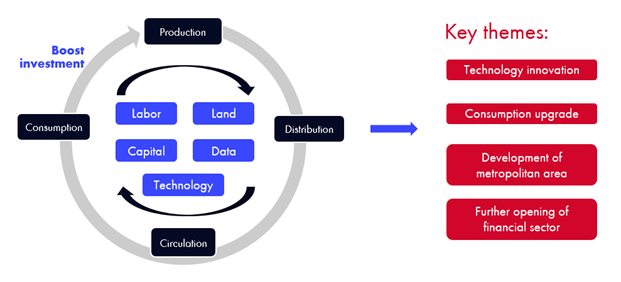Nordic Asia explains the Internal Circulation concept and why it is prioritized by China
Introduction
After a meeting on July 30, the Chinese Politburo announced that China will accelerate the establishment of a dual-circulation development pattern that takes the domestic market as the mainstay while domestic and foreign markets can boost each other. It emphasizes the strategical shift to China’s domestic economy.
Why this strategy was proposed
Under the background of decoupling and anti-globalization (US-China conflict, Brexit, Japan-Korean conflict, etc.), there are more and more uncertainties on the global economy. For China, the overseas market is shrinking due to the trade wars with entity lists and higher tariffs, which negatively impacts the export. In addition, it becomes more difficult to import products and services within high-technology. Therefore, focusing on the domestic market could bring new momentum to the Chinese economy.
How to circulate
The 4 steps to circulate are production, distribution, circulation, and consumption, respectively.
Production: focus on the stability and competitiveness of the supply chain
China is ranked 1st regarding the output value of the manufacturing industry. However, China’s production advantages are concentrated in low-value-added consumer products with relatively low technology barriers, while for high-value-added products, China has higher dependence on import. Therefore, China aims at 1) sustain the current cost advantages, 2) deploy on technology innovation for import substitution with higher R&D input, to lift the stability and competitiveness of the supply chain.
Distribution: focus on the fairness of distribution
Firstly, China aims to improve the allocation of urban and rural resources, to promote the balanced development of urban and rural areas. Besides, China plans to improve the income distribution system and promote the personal tax reform to narrow the gap between rich and poor, to further create a fair environment. It could help drive the consumption from the poor with higher disposable income.
Circulation: focus on the efficiency with the development of metropolitan areas
The circulation involves all 5 production factors including labor, land, capital, technology, and data, and the key theme is the metropolitan area development model. It could help increase the efficiency and lower the cost within a specific metropolitan area (the Greater Bay Area, Yangtze River Delta, etc.), especially on transportation, logistics, and supply chain management.
Consumption: focus on the consumption upgrade trend and lift the domestic demand
China policy makers are trying to tap into the potential of China’s enormous consumer market and aims to deepen the supply-side reform to accelerate the pace of consumption upgrade (e.g. shifting to high-quality goods, spending more on services etc.). Besides, the government is issuing more duty-free licenses to enterprises, and is raising the duty-free shopping quota for Hainan province in order to bring external consumption back to China.

What to drive the domestic demand
Export accounts for ~15% of China’s GDP. To ease the reliance of external demand, both domestic investment and consumption need to accelerate.
Which sectors to benefit from this new shift
Consumer goods:
The consumption upgrade trend will focus on discretionary consumer sectors including duty-free, e-commerce, and gaming, etc.
Technology:
- Industrial upgrading to high-end manufacturing 2) Import substitution with technology innovation, focusing on semiconductors, cloud computing, new energy vehicles, industrial automation, etc.
Infrastructure:
Domestic investments for both traditional infrastructure and new infrastructure, focusing on IDC, new energy, construction materials, industrials, etc.
Finance:
Further opening up of the financial sector, focusing on fintech, brokers, insurance, etc.
Service:
Increase the scale and profitability of the tertiary industry, focusing on healthcare, social services, logistics, property management, etc.